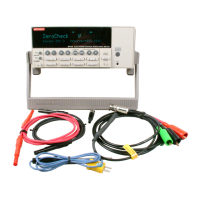IEEE-488 Reference
3-89
3.19.5 :NPLCycles <n> [:SENSe[1]]:VOLTage[:DC]:NPLCycles <n> Set NPLC for Volts
[:SENSe[1]]:CURRent[:DC]:NPLCycles <n> Set NPLC for Amps
[:SENSe[1]:RESistance:NPLCycles <n> Set NPLC for Ohms
[:SENSe[1]]:CHARge:NPLCycles <n> Set NPLC for Coulombs
Parameters <n> =0.01 to 10Power line cycles per integration
DEFault 1
MINimum 0.01
MAXimum 10
Query :NPLCycles? Query programmed NPLC value
:NPLCycles? DEFault Query *RST default value
:NPLCycles? MINimum Query minimum NPLC value
:NPLCycles? MAXimum Query maximum NPLC value
Description The integration period (measurement speed) for the Model 6517A can be set using either of two
commands; :APERture (paragraph 3.19.4) or :NPLCycle. Aperture specifies time (in seconds)
per integration, while NPLC expresses the integration period by basing it on the power line fre-
quency. See paragraph Section 2 for details on integration (SPEED).
When the integration period is set using the :NPLCycles command, the time value for the :AP-
ERture command changes accordingly to reflect the new integration rate. Conversely, if the in-
tegration period is set using the :APERture command, the value for the :NPLCycle command
changes accordingly.
On power-up, the instrument uses the NPLC value to determine the integration period.
Note: If line synchronization is enabled (see:LSYNc command in SYSTem subsystem), the in-
tegration period will not start until the beginning of the next power line cycle. For example, if a
reading is triggered at the positive peak of a power line cycle, the integration period will not start
until that power line cycle is completed. The integration period starts when the positive-going
sine wave crosses zero volts. See paragraph 2.19.8 for more details.
:AUTO <b>|ONCE
[:SENSe[1]]:VOLTage[:DC]:NPLCycles:AUTO <b>|ONCE Control auto NPLC for volts
[:SENSe[1]]:CURRent[:DC]:NPLCycles:AUTO <b>|ONCE Control auto NPLC for amps
[:SENSe[1]:RESistance:NPLCycles:AUTO <b>|ONCE Control auto NPLC for ohms
[:SENSe[1]]:CHARge:NPLCycles:AUTO <b>|ONCE Control auto NPLC for coulombs
Parameters <b> =1 or ON Enable auto NPLC
0 or OFF Disable auto NPLC
ONCE Enable and then disable auto NPLC
Query :AUTO? Query state of auto NPLC
Description These commands are used to enable or disable auto NPLC for the specified measurement func-
tion. With auto NPLC enabled, the instrument automatically optimizes the NPLC value for the
present resolution setting. Table 2-17 provides the integration times for SET-BY-RSLN (AUTO).
The ONCE parameter is analogous to a momentary toggle switch. When :AUTO ONCE is sent,
auto NPLC turns on momentarily and then disables. While enabled, it automatically selects the
appropriate value as summarized in the tables. When auto NPLC disables, NPLC remains at the
selected value.

